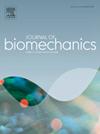Computational modeling of biomechanical response of osteocyte integrin and cytoskeleton based on the piezoelectricity of bone matrix
IF 2.4
3区 医学
Q3 BIOPHYSICS
引用次数: 0
Abstract
Osteocytes are key in bone remodeling, responding to mechanical stimuli. The piezoelectric bone matrix converts these stimuli into electrical signals, influencing remodeling. To delve deeper into this, we created an osteocyte model within a piezoelectric bone matrix, incorporating the lacuna-canalicular system and mechanosensors such as integrins, cytoskeleton, and primary cilia. Upon subjecting the bone matrix to triaxial dynamic displacement loads, we examined the electric potential and flow velocity distributions and analyzed the mechanical signals of six mechanosensors. The results show that the strain is greater when the bone matrix is piezoelectric than non-piezoelectric. The maximum average potential of the surface structure of the cell membrane is about 69.3 mV. Piezoelectricity significantly increases the fluid velocity and changes the trend. The cytoskeleton and integrins in cell process experience greater stress than in cell body. Microtubules experience greater stress than actin filaments. Among all integrins, those in contact with collagen hillocks experience the greatest stress. In individual integrin, the β subunit has higher stress than α subunit, and the stress of legs connected to cytoskeleton is higher than head contacted with fluid. Within the cytoplasm, the stress of integrin increases with a decrease of the surrounding cytoskeleton density. Moreover, collagen hillocks have the greatest fluid shear stress and stress. Integrins, primary cilia, and cytoskeleton all exhibit significant displacement signal amplification, especially integrins. In conclusion, this study illuminates the complex process of mechanosensing in osteocytes within a piezoelectric environment. The established model offers valuable insights into the mechanism of osteomechanical signal transduction.
基于骨基质压电性的骨细胞整合素和细胞骨架生物力学响应计算模型
骨细胞是骨重塑的关键,对机械刺激作出反应。压电骨基质将这些刺激转化为电信号,影响骨重塑。为了更深入地研究这一点,我们在压电骨基质中创建了一个骨细胞模型,结合了腔隙-管系统和机械传感器,如整合素、细胞骨架和初级纤毛。在三轴动位移载荷作用下,我们检测了骨基质的电位和流速分布,并分析了六个机械传感器的机械信号。结果表明,骨基质为压电时的应变大于非压电时的应变。细胞膜表面结构的最大平均电位约为69.3 mV。压电性显著地提高了流体速度并改变了趋势。细胞过程中的细胞骨架和整合素承受比细胞体更大的压力。微管比肌动蛋白丝承受更大的压力。在所有整合素中,与胶原丘接触的整合素承受的压力最大。在单个整合素中,β亚基的应力高于α亚基,与细胞骨架连接的腿的应力高于与液体接触的头部。在细胞质内,整合素的胁迫随周围细胞骨架密度的降低而增加。胶原丘具有最大的流体剪切应力和应力。整合素、初级纤毛和细胞骨架都表现出明显的位移信号放大,尤其是整合素。总之,本研究阐明了压电环境下骨细胞机械传感的复杂过程。所建立的模型为骨力学信号转导的机制提供了有价值的见解。
本文章由计算机程序翻译,如有差异,请以英文原文为准。
求助全文
约1分钟内获得全文
求助全文
来源期刊

Journal of biomechanics
生物-工程:生物医学
CiteScore
5.10
自引率
4.20%
发文量
345
审稿时长
1 months
期刊介绍:
The Journal of Biomechanics publishes reports of original and substantial findings using the principles of mechanics to explore biological problems. Analytical, as well as experimental papers may be submitted, and the journal accepts original articles, surveys and perspective articles (usually by Editorial invitation only), book reviews and letters to the Editor. The criteria for acceptance of manuscripts include excellence, novelty, significance, clarity, conciseness and interest to the readership.
Papers published in the journal may cover a wide range of topics in biomechanics, including, but not limited to:
-Fundamental Topics - Biomechanics of the musculoskeletal, cardiovascular, and respiratory systems, mechanics of hard and soft tissues, biofluid mechanics, mechanics of prostheses and implant-tissue interfaces, mechanics of cells.
-Cardiovascular and Respiratory Biomechanics - Mechanics of blood-flow, air-flow, mechanics of the soft tissues, flow-tissue or flow-prosthesis interactions.
-Cell Biomechanics - Biomechanic analyses of cells, membranes and sub-cellular structures; the relationship of the mechanical environment to cell and tissue response.
-Dental Biomechanics - Design and analysis of dental tissues and prostheses, mechanics of chewing.
-Functional Tissue Engineering - The role of biomechanical factors in engineered tissue replacements and regenerative medicine.
-Injury Biomechanics - Mechanics of impact and trauma, dynamics of man-machine interaction.
-Molecular Biomechanics - Mechanical analyses of biomolecules.
-Orthopedic Biomechanics - Mechanics of fracture and fracture fixation, mechanics of implants and implant fixation, mechanics of bones and joints, wear of natural and artificial joints.
-Rehabilitation Biomechanics - Analyses of gait, mechanics of prosthetics and orthotics.
-Sports Biomechanics - Mechanical analyses of sports performance.
 求助内容:
求助内容: 应助结果提醒方式:
应助结果提醒方式:


